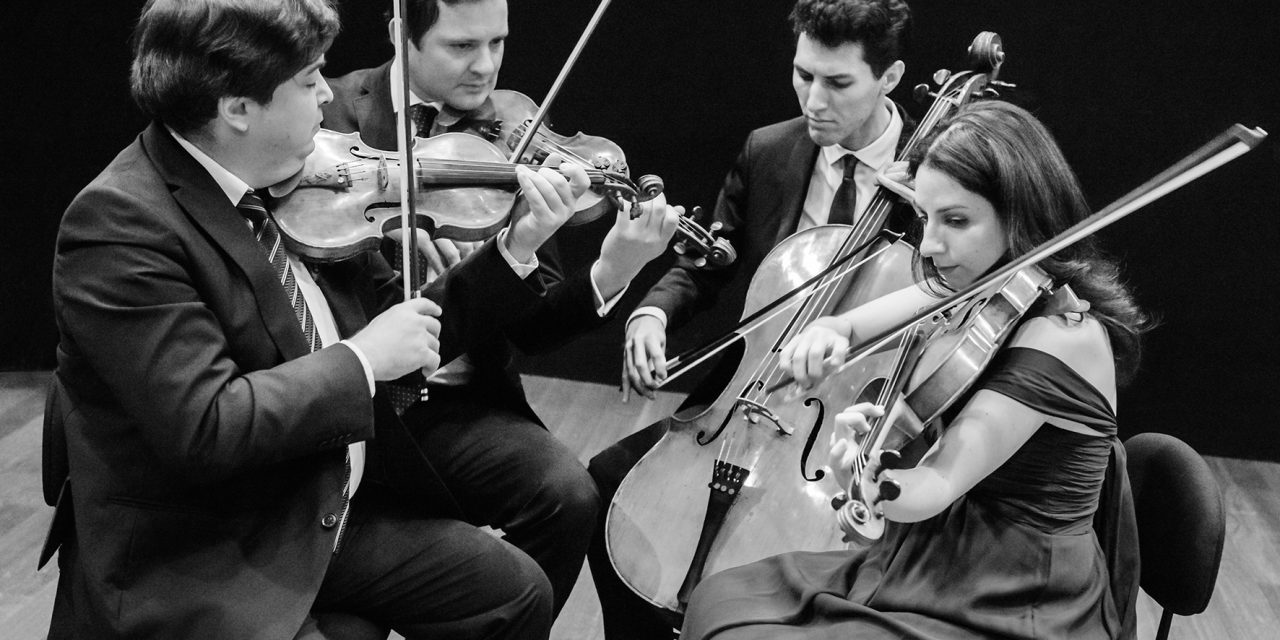Elegant, captivating, and harmonic, are just three out of a million words that I feel best describe the lush sounds of classical music. From Mozart, who practically defined the term classical, to Beethoven, who revolutionized the orchestra world with his enchanting melody of romanticism. We have all most likely heard some form of art music, even if it may have been while riding the hotel elevator. Just like films, the art of classical music is made up of many genres such as romantic and opera. However, there is a style that is unique from the rest, this genre is known as chamber music. What makes this form so unique compared to the rest is that there is no conductor, each instrumentalist who is a part of the ensemble, plays as a soloist but works with one another to compose a harmonic tune. Artists of Aviv Quartet execute all the complexities that come with composing an art from like chamber, in their newest album, Schubert: The Last Quartets.
The Aviv Quartet is made up of four composers Noemie Bialobroda, Sergey Ostrovsky, Evgenia Epshtein, and Daniel Mitnitsky. The name Aviv holds a much deeper meaning for the quartet. In Hebrew, Aviv means ‘spring,’ it symbolizes the start of a new beginnings and the season of birth and fresh thinking.” The Aviv Quartet’s display this “artistic philosophy” by stripping away what was artificial about a classic covering to reveal its true nature, sharper definition and perception. The Quartets have made many significant coverings since they’ve started, and their hard work has not gone unnoticed. They were the winner of the Grand Prix and over ten other Prize awards. They Quartets were even awarded three several government prizes. The ensemble originated in Israel in 1997 and have been performing internationally for over 15 years. Some notable venues they’ve performed at would include Carnegie Hall and Alice Tully Hall in New York, Kennedy Center and the Library of Congress in Washington, and the Louvre Auditorium, Theatre du Chatelet and Theatre de la Ville in Paris.
The Quartet’s newest album encompasses Franz Schubert’s and his last two quartets. Schubert’s last quartets hold historic value due to him successfully writing and composing these pieces of art while knowing he was on the verge of death. If you’ve ever had the chance to listen to his original pieces you most likely heard his struggles of dealing with death, but if not, I’m here to explain how Franz went about composing these woeful melody’s. By using the four movements of the “Death and the Maiden” quartet, which are allegro, andante, scherzo, and presto. In movement one, the longest movement of the four, he uses allegro to set up the main theme, “struggle with death.” He creates violent shifts in tone by playing the opening chords all in minor keys (which produce a bass like sound). Franz uses the movement andante to introduce a moody adagio (slowly played) movement for his second of the four. In his third movement, which is the shortest of the four, Schubert ships tones from adagio to lively scherzo. His third act is also known as “the dance of the demon fiddler.” In his fourth and final movement, Franz transforms this act into a raging rondo that keeps the dotted rhythm from the Scherzo movement as it turns around and around in a traditional dance form called the tarantella. The significance of this final movement is that the term tarantella was traditionally thought to be a dance to ward off madness and death and at this late point in Franz Schubert’s life he was certainly grappling with these big themes – death, spirituality, inner struggle.
The Aviv Quartets dedicated several years to enhancing and maturing each work as an individual rather than imposing an overarching style. The variation in Quartets Scherzo compared to Schubert’s highlights the group’s attentive treatments to fast movements by having small variations in tempo, this helped to contribute to the overall feeling of instability sound from the Château Fallot in Lausanne. This prestigious ensemble does an outstanding job of revamping and adding complexity to this once familiar genre of music.
Photo Credits: https://aicf.org/artist/aviv-quartet/






